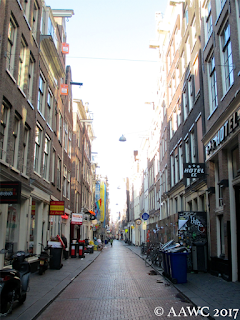Woke at 7am, having actually had a good night’s sleep, despite our hotel being inside the Red Light District (our room’s position on the third floor may be what’s keeping the sound out), we got up and got ready for the day’s events.
We had to wait downstairs for a few minutes before the buffet opened at 8am and amused ourselves by examining the wall in the foyer, which was decorated with fake books (barely an inch long) on fake shelves – one of the fake books was even loose.
I was delighted to discover that in the Netherlands it’s perfectly acceptable to spread sprinkles on your bread of a morning – in fact, they even sell portion-sized packs! It was one of these that I used on my breakfast, as well as a hot chocolate from a machine. A pretty decent spread for 8 euro each! And now I’m wondering if Australia’s fairy bread tradition harks back to immigrants from Holland.
Then it was time to find our way to the Anne Frank House. We arrived by the same roads that the Nazis paraded down when the Netherlands capitulated (they had decided to remain neutral at first, hoping this would save them from Hitler – it didn’t).
It was cold in the shade and there I was in one jumper, trying not to shiver. We were too early for our 9:15am slot. We watched many people get turned away and told to try again at 3:30pm, when online ticketing gives way to walk-ins. Waiting there, I could see nearby buildings that Anne Frank saw, heard the church bell that she had heard (well, not the exact same one, since the original was melted down in WWII for the war effort).
The time came to go inside. We were once again delayed, however, by the four women in front of us who needed their tickets sorted out – they had only printed one ticket instead of all four. They were pulled out of the line so we were able to move again.
As I entered through the secret door (behind a reconstructed bookcase) and began to ascend the steep stairs, I was confronted with questions – did Anne feel similarly challenged by this space the first time she saw it? Did her knees hit each step as she climbed the stairs?
The house was packed, but I enjoyed seeing the rooms mentioned in Anne Frank’s diary, including where she slept and wrote her pages. What a small, cramped and dingy place that formed her retreat, but brought to life by the “movie stars” she stuck on the wall.
It was fascinating, matching the other rooms to my memories of the book, recently read. I treated it a bit like a puzzle. But then I saw a photo of Otto Frank (Anne’s father and the only one of eight fugitives to survive), standing at the secret annex by himself in 1960. Alone.
I bought some items in the gift shop and walked outside, fighting tears.
“It’s not fair! It’s not fair!” I said, clutching The Husband.
I always hope that the ending to Anne’s story changes.
But it doesn’t.
Back to the hotel, then we were fortunate to almost immediately board a canal tour near Amsterdam Centraal station (which, according to recorded voices in 4 languages, was built in the 19th century on a manmade island).
We bought water from a vendor and just generally enjoyed the ride on both rivers that had been altered into canals. I had a great seat, one with a moveable window, so I took many snaps outside, though we were on the opposite side to the Anne Frank House.
Earlier, on our way to the Anne Frank House, we had seen removalists using a ladder-esque motorised platform to move someone out of their apartment. Then we noticed hooks set into the top of each narrow, listing house and thought rope must run through the hooks to help unload/load when the stairs won’t take your furniture – the audio tour confirmed our theory.
Land was in very short supply here in the 17th century onwards, so that is why the houses are so tall and teetering. We saw a house that was less than 2 metres wide – and parts of the original medieval fortifications.
The city wall is gone, now replaced by those tall houses, but it once ran along the opposite side of the canal, performing the purpose of a moat. Some towers remain, such as the one called “Crazy Jack” (18th century additions included extra levels and a clock, which always ran on a crazy time), but they look odd and out of place.
We returned to the square where we’d set off from and acquired food. Well, first I had a chocolate-smothered waffle, which I ate while grinning at a cat (I’d seen it roaming the street yesterday). It was curled up and sleeping in an adult shop window, surrounded by vibrators.
Lunch (proper lunch!) was found at an Asian “pick your own noodles, extras and sauce” place. Pretty good food, giant portion sizes.
We walked down to Crazy Jack to get better photos of it and discussed whether or not the old wall would have kept the Nazis at bay. In the end, we decided no, because walls were old technology – and tanks would have made short work of them.
Back to the hotel.


No comments:
Post a Comment